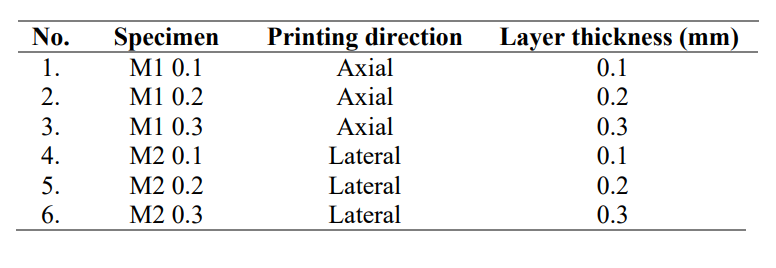Materials are being further scrutinized in 3D printing as authors S.T. Dwiyati, A. Kholil, R. Riyadi, and S.E. Putra study properties of Acrylonitrile Butadiene Styrene (ABS) with axial and lateral direction. Their findings are outlined in ‘Influence of layer thickness and 3D printing direction on tensile properties of ABS material,’ a paper recently published in the Journal of Physics: Conference Series.
While numerous, previous studies have focused on mechanical properties, printing orientation, tensile strength, and more, for this research the authors focused on samples with one-layer thickness only; however, there were variances in both printing and thickness. In these cases, three test specimens were produced.
3D files were converted for translation in the ‘UP Box 3D printer application, as the researchers printed each sample separately according to desired printing direction and layer thickness.
Both tensile and SEM testing were used to test strength by pulling samples to the point of fracture. This was accomplished with a Zwick Roell Series Z 020 tensile testing machine, with each set of sample tests performed three times. SEM tests were performed on the materials, as the researchers examined the fracture surfaces in detail.
Average data results are displayed below.
Tensile tests of the materials revealed greater molecule strength in one layer—rather than inter layers—due to the same amount of heating and cooling, and stronger bonding. Thicker layers allow for stronger bonds with increased polymer chains.
“The thickness of the 0.1 layer for axial direction shows higher force values and tensile strengths compared to layer thickness 0.2,” concluded the researchers at the end of their study. “These results indicate similarities with Divyathej’s that layer thickness affects the tensile strength. The printing orientation affects the tensile test results. In the axial direction shows a higher tensile strength value when compared with the lateral direction.
“Among the six specimens, specimen M1 0.3 has maximum force and the largest tensile strength. The SEM images were observed that the stacking of the axial direction was less dense, and many voids compared with the lateral direction layer. The more layers will form a tight structure, but the strength inter layers is lower than the strength between polymer molecules in one layer.”
Mechanical properties of a variety of materials continue to be examined, experimented on, and tested by researchers, engineers, and users around the world, as they study issues like porosity and the effects on both prototypes and functional parts, explore more about biocompatibility in materials for 3D printing, build orientations when printing with metal, and much more.
What do you think of this news? Let us know your thoughts! Join the discussion of this and other 3D printing topics at 3DPrintBoard.com.
[Source / Images: ‘Influence of layer thickness and 3D printing direction on tensile properties of ABS material’]Subscribe to Our Email Newsletter
Stay up-to-date on all the latest news from the 3D printing industry and receive information and offers from third party vendors.
Print Services
Upload your 3D Models and get them printed quickly and efficiently.
You May Also Like
3D Printing News Briefs, July 2, 2025: Copper Alloys, Defense Manufacturing, & More
We’re starting off with metals in today’s 3D Printing News Briefs, as Farsoon has unveiled a large-scale AM solution for copper alloys, and Meltio used its wire-laser metal solution to...
Etsy Design Rule Change Reduces Selection of 3D Printed Goods
Online marketplace Etsy has implemented a rule change requiring all 3D printed goods on the site to be original designs. The update to the site’s Creativity Standards states, ¨Items produced using...
Siraya Tech Introduces New Elastomer 3D Printing Materials, Including Foaming TPU
California company Siraya Tech, founded in 2019 with a focus on material science, customer focus, and agility, develops high-quality 3D printing materials that meet the needs of creators, hobbyists, and...
3D Printing News Briefs, April 12, 2025: RAPID Roundup
The news from last week’s RAPID+TCT in Detroit just keeps on coming! That’s why today’s 3D Printing News Briefs is another RAPID Roundup of more exciting announcements from the trade...









































